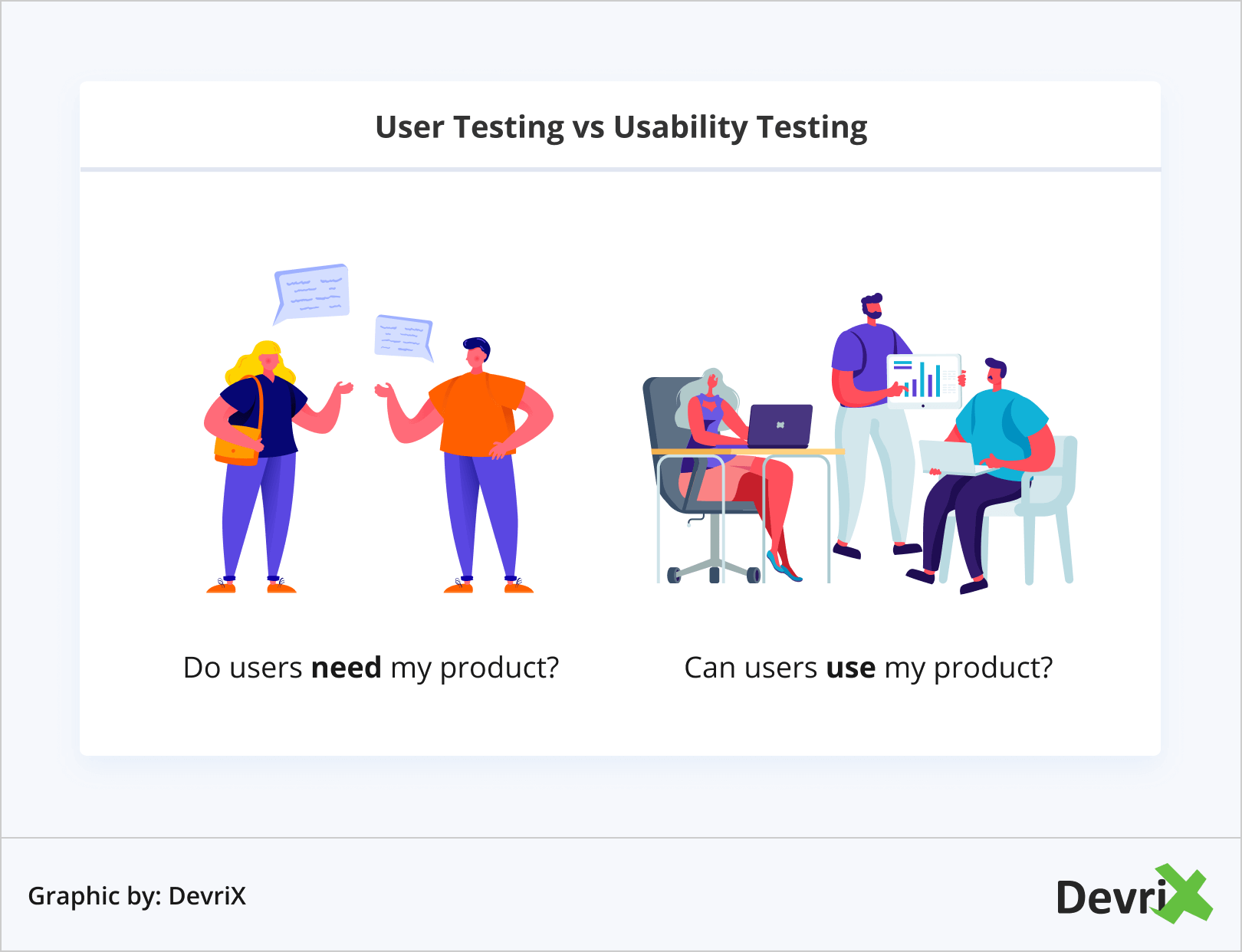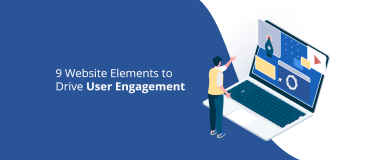User testing is a technique of having end-users and prospective customers test your product, website features, or prototype. It’s the process where test subjects use the item to identify any positive or negative attributes so that the business can iron out the wrinkles in their product before it goes to market.
With user testing mothods, you can track the success of your product from the customer’s point of view. By watching, listening, and reviewing how they interact with it, you can gain powerful insight on whether your product is effective and performing as expected.
Thanks to user testing you can clearly see where your efforts fall short in the eyes of your target audience. While your team of designers, developers, and all the people involved in creating the product find it easy to use, this might not be the case with users.
Because every product, feature, or prototype is unique, there are various user testing methods that you can employ. In this article, we’ve put together a guide telling you what the different user testing methods are and have outlined a few tips to help you do user testing right.
The Value of User Testing
Testing your product, feature, or prototype with a sample of your target audience will help you make better and more cost-effective decisions regarding improvements. Making changes to a new product before releasing it out to the public means fewer reworks and fewer expenses along the way.
User testing is a good management practice that can give you valuable insights into how prospects interact with and perceive your offer, thus helping you improve their experience. By understanding the user behavior up-close you can make much more specific adjustments through the various stages of their user journey.
You should do user testing at any point in the development process. This nonlinear approach is an essential part of any iterative design process. By listening to your audience’s feedback and changing the product repeatedly at the different stages you’d be able to detect any usability issues faster and ensure that the final product is ready to be launched.
With all that said, it’s important to establish a user testing framework before you create your actual product, during its creation, and after you have a finished version. There are various methods of user testing to try and adapt, so let’s examine some of them.
User Testing Methods
Usability Testing
Usability testing is essential when you provide your test subjects with a sample of your product, so they can test and assess its usability. This can refer to different factors such as how useful the product is, how easy it is to use, what kind of utility it provides, etc. Hence, it allows you to understand how intuitively your product actually is for customers to use.
While the definition of usability testing sounds quite similar to that of user testing, there are some key differences:
- User testing covers a whole range of experiences a user has with your product from when they obtain it until they stop using it. This includes their emotions, perceptions, responses, preferences, and behaviors.
- Usability testing focuses on evaluating if your audience can effectively use your product. This means identifying what are the points of frustration for your users when interacting with your product and what you can do to eliminate them.

Additionally, usability testing can be moderated and unmoderated.
- Moderated user testing – In this case, one of your team members is present while the user tests your product. The moderator’s role is to provide help and guidance along the process and listen to the users’ feedback after. It’s an appropriate option to choose if you would prefer to observe user interactions in real-time.
- Unmoderated user testing – This is where there’s no interaction or communication with the user. Instead, the process – both the testing and the feedback, is recorded. It works well if you’d like to conduct the testing with a large group of participants from different areas at the same time.
Keep in mind that usability testing should be conducted at the initial to mid-stages of designing your product to ensure that every aspect works properly.
Read also: Usability Testing Checklist for Your WordPress Site
A/B Testing
A/B testing is where test subjects are divided into groups and asked to examine different versions of the same prototype simultaneously. This approach lets you see which version of your product provides a better user experience, and meets your customers’ needs and preferences.

A/B testing is ideal when you want to make an informed decision regarding how well one version performs against another. This method is a great way to help you learn or reaffirm what really works best for your users. Even if you think you know your customers well based on the information you have on your target audience and your buyer personas, the test may surprise you.
Surveys
Surveys offer an easy method to obtain feedback from your target audience. They are convenient too because participants can complete them at their own pace. Moreover, surveys are easy to send to large groups and extract the most relevant information once they are completed. Hence, they are great if you wish to receive a wide range of responses in a short amount of time.

With a survey you can:
- Gather, organize and analyze both quantitative and qualitative data.
- Use various types of surveys such as customer satisfaction surveys, customer experience surveys, net promoter score surveys,s and more.
- Ask your test subjects questions of your choice. When you do that just make sure you select the ones that can give you meaningful and unbiased results.
When conducting your survey, make sure to send it to random actual users or to potential users.
Focus Groups
Focus groups are where a moderator has an open discussion with a small group of consumers (usually between 10-12) about the various attributes of a product. This discussion is usually led by specific team members – designers, developers, or marketers.

The role of the moderators is to bring up particular aspects of the usability of the product to ensure that the right feedback will be obtained. The end goal is to be able to address the concerns of the participants, so designers can get a better idea of what to improve and why.
This method of user testing can be very useful if your test subjects need to be given a bit of guidance before they can directly access a specific feature of the product. This way you can focus on the particular aspects that matter most.
How to Conduct User Testing
Create a Minimal Viable Product (MVP)
This first step of conducting user testing is quite obvious – you can’t do user testing without something that needs to be tested. In other words, you need to create a prototype or a minimal viable product. This may be a brand new product or feature, an updated version, or a sample/demo of a feature you’re thinking of including
Choose Your Method of Testing
Once you have your MVP, you need to choose a method of testing. Consider what type of information you’re looking for. Then evaluate which test method would be most suitable, so you can get the needed results in a way that makes sense for your business.
Additionally, you should decide whether you should:
- Use a click test or a system usability scale for problem discovery.
- Observe how easy or difficult it is for users to learn how to use your product.
- Show competitive products both created by your brand.
- Use eye-tracking analysis while subjects test your product.
Read also: How to Implement Google Site-Wide Tagging on Your Website
Recruit The Right Test Subjects
Recruiting the right users to test your MVP is crucial for obtaining optimal results. You should choose people who are part of your target audience and fit your target personas. This will help you achieve more accurate results and data from the ones who will buy, use, and promote your products.
To recruit the test subjects you can:
- Contact existing customers – You can look through your client database and contact users who have signed up for your email list.
- Reach out to your network – Recruit test subjects from the social media platforms you use – Facebook, Twitter, Instagram, etc. or ask for referrals from your professional network or your employees.
- Use testing services – If your project is large and your business has enough resources, you can contact third-party services to connect with the right test subjects.
Set the Time and Place for Your Test
Setting the time and location of user testing will depend on your MVP and more specifically, its capabilities and functions.
When choosing the place you should consider the surroundings and avoid potential distractions. If you conduct your test remotely, make sure to give proper instructions to your test subjects so they can create an optimal test environment themselves.
When setting the time, make sure you let the users know how long the test will last and give them an overview of what it will include.
Give Clear Instructions
In order to get valuable results, it’s crucial to set clear goals of what the test is trying to achieve and communicate them to your test subjects. You should give out clear instructions and guide them through the test so they know what is expected from them.
Additionally, let your participants know how you’d collect and analyze the data. Ask them if they have any questions about specific aspects of the process and make sure they have all necessary equipment – like a webcam or screen sharing software.
Analyze the Results
Once the testing is done and you’ve gathered all the data you need, it’s time to analyze the results. To create a thorough analysis, consider everything that the participants have to say. Evaluate the major and minor trends and patterns you find, then head back to the drawing board to make the necessary adjustments.
Some of the most common user testing metrics include: how successfully the task was completed, were there any critical and non-critical errors that might have prevented the completion of the task, did any subjects manage to complete the task without any errors, and what were their subjective opinions?
Read also: 11 Key SaaS Growth Metrics to Track in 2021
Conclusion
User testing is a powerful tactic all companies can leverage. It provides actionable, real data directly from your target audience, enabling you to ensure that all aspects of your product are perfected before being launched.
It’s a process that requires a few steps, yet has great results. By using a prototype of a minimal viable version of your product you can save valuable time and resources you can allocate towards improving user experience.



![Influencer Marketing Statistics Every Business Should Know [Infographic]](https://devrix.com/wp-content/uploads/2019/10/Influencer-Marketing-Statistics-Every-Business-Should-Know-Infographic@2x-380x160.png)
